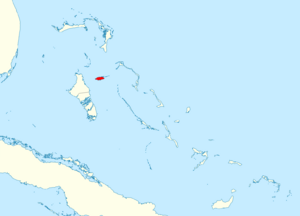Brace's emerald facts for kids
Quick facts for kids Brace's emerald |
|
|---|---|
 |
|
| Artist rendition | |
| Conservation status | |
| Scientific classification | |
| Genus: |
Riccordia
|
| Species: |
bracei
|
 |
|
The Brace's emerald (Riccordia bracei) was a tiny, sparkling hummingbird that used to live only on New Providence, a main island in the Bahamas. This special bird was endemic to that island, meaning it wasn't found naturally anywhere else. Sadly, this beautiful species is now extinct, meaning it no longer exists anywhere in the world. Scientists believe it disappeared around 1877.
Contents
What Did Brace's Emerald Look Like?
This small hummingbird weighed about 12.3 grams (0.43 ounces), which is less than a handful of coins! Its wings stretched about 9.25 inches wide, and the bird itself was about 5.5 inches long from head to tail. Its tail alone was about 2.5 inches long.
Colors and Features
The Brace's emerald had a short, mostly straight, black bill. Its legs and feet were also black.
- Body Colors:
- Its back and head were a slaty blue color, almost like a dark gray-blue, with a shiny black gleam on its back.
- Right behind its eyes, it had a clear white "eyebrow" stripe.
- Its throat was white.
- The belly had white feathers mixed with black and yellow spots.
- Its wings looked bluish and had white stripes.
- The tail feathers were blackish.
- The feathers under its tail, near its body, were white with a light yellow tint at the edges.
How Did Brace's Emerald Become Extinct?
For a long time, scientists only knew about Brace's emerald from one single male bird. This bird was collected by Lewis J. K. Brace on July 13, 1877. He found it about 4.8 kilometers (3 miles) from Nassau on New Providence island. This single bird is called the "type specimen" because it's the main example used to describe the species.
A Long-Lost Discovery
The skin of this bird, even though it's damaged, is now kept at the Smithsonian Institution in Washington, D.C.. For many years, other bird experts didn't pay much attention to it. In 1880, some thought it was just a type of Cuban emerald (Riccordia ricordii).
It wasn't until the 1930s that scientists realized this bird from New Providence was unique. An American bird expert named James Bond (yes, like the famous spy, but he was a bird scientist!) was the first to really study the differences. In 1945, he suggested that the Brace's emerald was a separate kind of hummingbird. The New Providence bird was smaller than the Cuban emerald, had a longer bill, and different feathers.
Finding More Clues
In 1982, scientists who study ancient life, called palaeornithologists, made an exciting discovery. William Hilgartner and Storrs Olson found old fossil bones of three hummingbird species in a cave on New Providence. These fossils were from the Pleistocene epoch, which was a very long time ago.
They found fossils of the Bahama woodstar and the Cuban emerald. But they also found fossils of another species, which they later identified as Riccordia bracei – the Brace's emerald! This was important proof that Brace's emerald had lived on New Providence for thousands of years.
The Brace's emerald was a "relict population," meaning it was a small group of birds that were left over from a larger, older population. Sadly, it's believed that changes to its home (habitat loss) and human activities like farming led to its extinction by the end of the 19th century. Both R. bracei and R. elegans are now listed as extinct on the 2024 IUCN Red List, which tracks the conservation status of species worldwide.


